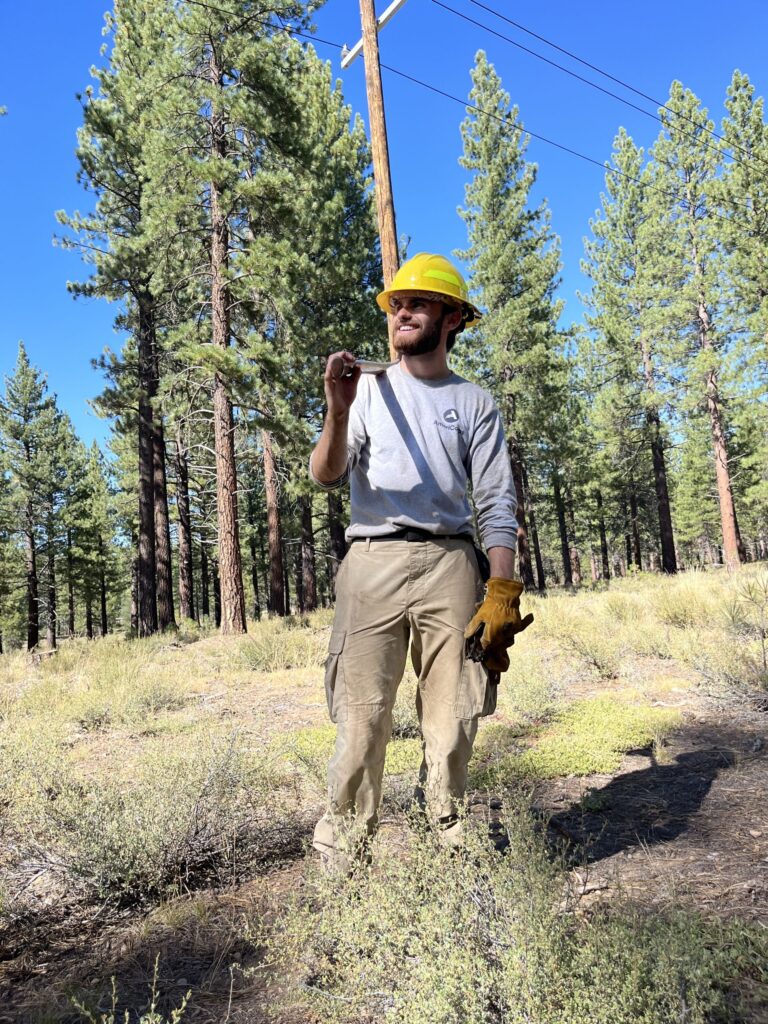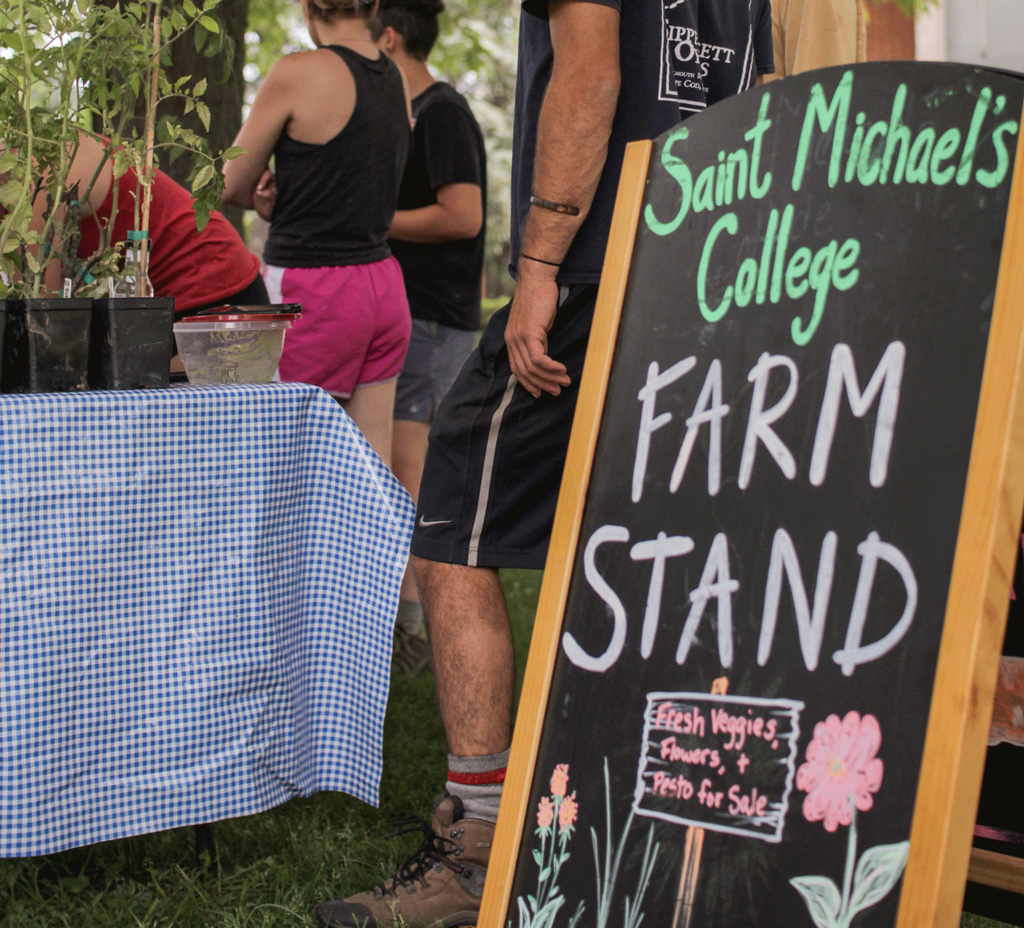Tree-planting plans for Earth Week speak to environmental commitment

The large image behind the headline above shows a tree-planting initiative from last year, in the Natural Area.
For Earth Week 2023 — from April 16 through Earth Day on April 22 – Saint Michael’s College faculty, staff, students and administrators actively will be demonstrating the institution’s commitment to environmental issues, including a major tree-planting initiative.

Kristyn Achilich ’05
Leaders of Earth Week campus activities alongside Kristyn Achilich ’05, director of the College’s Center for the Environment, are Professors Declan McCabe (biology) and Trevien Stanger (environmental studies and science) with Ryan Longe and his Facilities crew.
In a campus-wide communication recently, focused in particular on the importance of tree-planting initiatives, McCabe said, “One essential part of that planning is to ensure that we will have a more verdant, carbon-capturing, campus deliberately planted with diverse native trees.”
“This Earth Week we will realize part of this commitment by planting trees…lots of trees,” McCabe said. “These trees serve all audiences by making the place more attractive, but they will also serve essential educational roles by contributing to the campus a learning laboratory, canvas, and inspiration for scientists, artists, and writers. Shade, food, pollinators, native insects and birds, maple syrup, and carbon are all facets of this effort.”

Declan McCabe
The professor said Saint Michael’s once again has earned its 2022 “Tree Campus” designation, adding that “this planting will go a long way toward earning our 2023 honor.” In Vermont, only Saint Michael’s and Middlebury have earned this distinction, and Middlebury has a professional arborist pushing the process along, he said, adding, “We don’t have an arborist, but collaborations among Facilities, faculty, administrators, and students are filling that role.”
McCabe and College leaders note that one consistently growing student interest is in the environment, in slowing climate change, and in reducing our collective impact on biodiversity. “Saint Michael’s gradually is getting out in front as a stronger environmental leader by demonstrating our forethought by continuing to build our campus out to be carbon neutral or carbon negative, and also biodiverse. We need to continue this process and to accelerate it.”
Through the Center for the Environment, Achilich has been leading meetings to keep this process on track, and Stanger and Longe are part of that collaboration that has produced the plan — shown on the drawing above — to plant 21 large trees on Earth Week (map below). The organizers plan to share specific times and places for these activities soon throughout campus.
Achilich placed the tree-planting initiatives in the context of the Center’s broader mission and vision. “Leaders of Earth Month campus activities further model the integration and collaboration necessary to even begin to think about mitigating the intractable problems of climate change,” she said.
She said the Earth Month team includes the Program Coordinator of the Center at the helm, student Portia Butrym, ’23. “Alongside Portia are the members of the Center’s steering committee who help to plan and mobilize the divisions of campus we seek to engage,” said Achlich. Other community members she mentioned as central to the effort including Russ Sabens and Ryan Longe (facilities) and Janel Roberge ’12 (Registrar’s Office) who “works to align goals, funds and impact with other sustainable campus initiatives in her new part-time work with the Center.” Achilich also mentioned Christine Gall of the Farm & Food Program, who will lead a team to install a new raised bed project as the final addition to the spaces between Joyce and Alliot Halls – an effort coordinated collaboratively with CDEC and MOVE as well.
“A foundational aspect of the Center is to regularly partner with organizations in our community to build a network of stewards, weave a maze of communication, and focus what we do on campus in what is valued by our supporting community,” Achilich said. “Key partners this month are the Abenaki Land Link Project, a project supporting the Nulhegan Band of Coosuk Abenaki citizens, BranchOut Burlington and Horsford Nursery as the source of most of the 21 trees we will plant, part of a comprehensive sustainability plan for campus which allows us to in turn qualify for our Tree Campus USA certification.” Another partner is Casella, “our waste hauler for campus that provides a $1,000 stipend each year to pay for student internships focused on making sustainability accessible and maintainable year to year,” she said.
Achilich further emphasized that this model, in place for the last eight years with the Farm & Food Program and the last three since she moved over to lead the Center in 2019, is the foundation of the $6.5M award of funds from the Congressionally Directed Community Project Funds in the Omnibus Appropriations Act of 2023.
“[Now-retired] Sen. Patrick Leahy ’61 has demonstrated his faith in the Center to continue to leverage post-secondary opportunities to create a hub of education and workforce development for the environmental sector,” she said. “This work will begin its planning year this June and will engage stakeholders across campus, Vermont, and a variety of industry in the environmental sector and is only possible because of the work of Angela Irvine, director of sponsored programs, and many collaborative sessions with Dean Gretchen Galbraith.”
Achilich says this opportunity from the federal funds “is structured to benefit first the students, but second, to be used as an opportunity to build bridges across curricular and co-curricular programming further acknowledging that climate change is a complex systemic problem that requires coordinated collective and systemic action to solve. As a small, liberal arts, residential institution in a climate forward, service-minded state, we can be a lighthouse for the institutional models needed for coordinated systemic action.”
 Stanger shared a list of the wide variety of trees that will be planted: “Green Mountain” Sugar Maple, Shadblow Serviceberry, White Oak, “Macoun” Apple, Common Hackberry, Eastern Redbud, “Cherokee Princess” Dogwood, Yellow Delicious, White Spruce, Trembing Aspen, Musclewood, “American Sentry” Linden, “Emerald City” Tulip Poplar, “Liberty” Apple, “Northern Spy” Apple, “Lapins” Sweet Cherry, and “Bing” Sweet Cherry. This event will involve a great many students collaborating with faculty and with the professionals in Facilities. “Pre-dug holes, pre-staged trees, piles of our own compost closing the waste loop, keeping food waste on campus, and actually using it are all components of this process,” McCabe said. “From there we provide a pile of shovels and tap into the energy of our audience of willing 20 year olds! We are doing the real work; this is not window dressing.”
Stanger shared a list of the wide variety of trees that will be planted: “Green Mountain” Sugar Maple, Shadblow Serviceberry, White Oak, “Macoun” Apple, Common Hackberry, Eastern Redbud, “Cherokee Princess” Dogwood, Yellow Delicious, White Spruce, Trembing Aspen, Musclewood, “American Sentry” Linden, “Emerald City” Tulip Poplar, “Liberty” Apple, “Northern Spy” Apple, “Lapins” Sweet Cherry, and “Bing” Sweet Cherry. This event will involve a great many students collaborating with faculty and with the professionals in Facilities. “Pre-dug holes, pre-staged trees, piles of our own compost closing the waste loop, keeping food waste on campus, and actually using it are all components of this process,” McCabe said. “From there we provide a pile of shovels and tap into the energy of our audience of willing 20 year olds! We are doing the real work; this is not window dressing.”

This graphic shows central campus locations where trees will be planted according to present plans. Durick Library is at far left for reference.
Editor’s note: In the summer of 2024, the Center for the Environment was rebranded to the Institute for the Environment. This story was published before the rebrand and, thus, bears the previous name.





